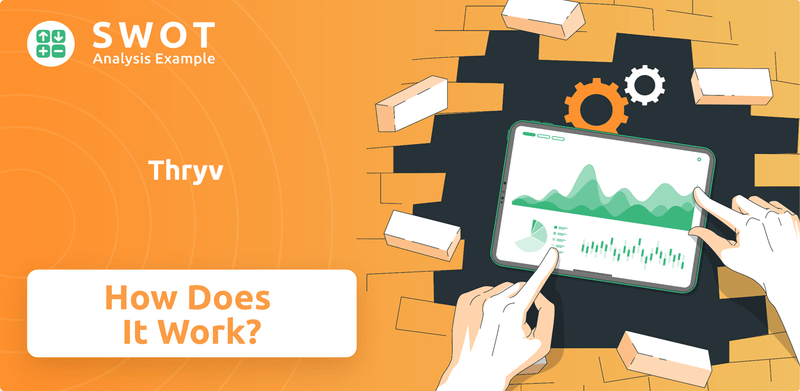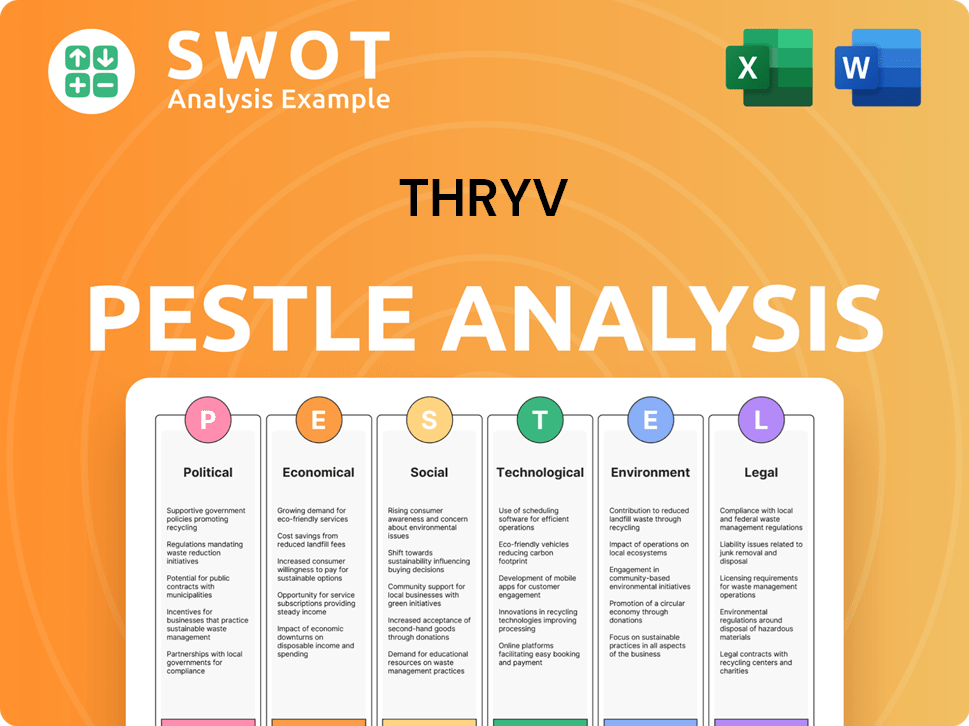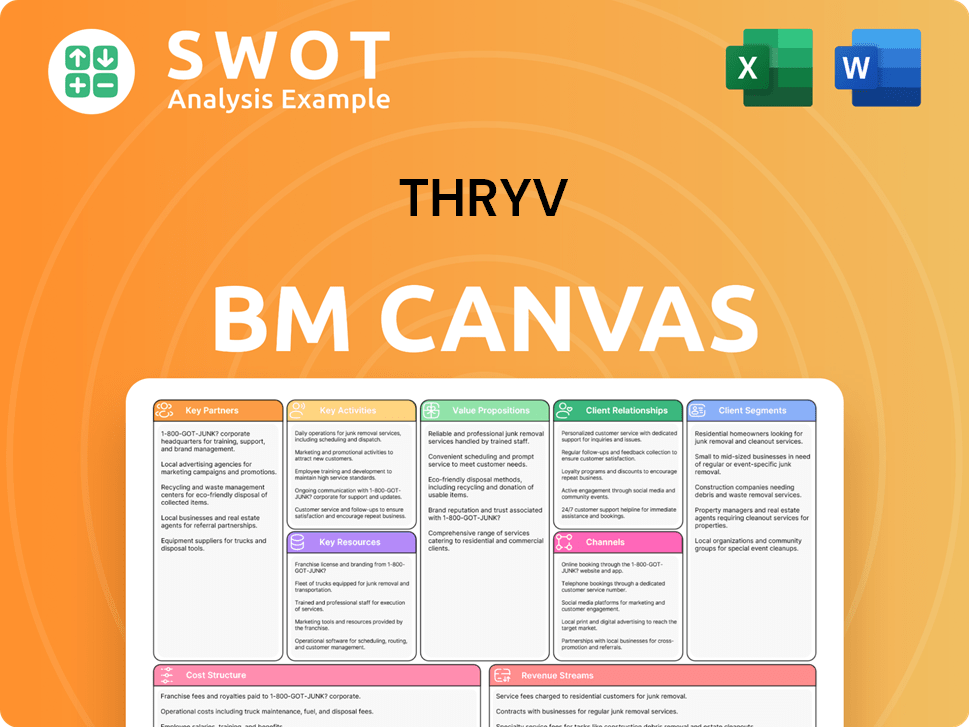Thryv Bundle
How Does Thryv Thrive in the SMB Software Arena?
Thryv Holdings, Inc. (NASDAQ:THRY) is rapidly transforming the small and medium-sized business (SMB) landscape, and investors are taking notice. Witnessing a remarkable 50% year-over-year surge in SaaS revenue in early 2025, Thryv is proving its mettle. But how does this Thryv SWOT Analysis reveal the secrets behind its success?

This deep dive explores the core mechanics of the Thryv platform, examining its impact on small business management through its CRM for small business solutions. We'll dissect how Thryv software empowers SMBs with integrated tools, including marketing automation and payment processing. Discover how Thryv's strategic shift and focus on customer experience are driving its impressive growth, making it a compelling case study in the dynamic world of business management software.
What Are the Key Operations Driving Thryv’s Success?
The core of how the Thryv company operates centers on delivering an all-in-one platform designed to streamline essential business functions for small and medium-sized businesses (SMBs). This integrated approach allows SMBs to manage various aspects of their operations from a single, centralized hub. The
The
Operational processes involve continuous technology development, a strong emphasis on customer service, and a robust digital platform. The cloud-based nature of the platform allows for scalable operations and expansion of the customer base without significant incremental costs. The company leverages its sales force to transition traditional Marketing Services clients to its SaaS offerings, which is a key strategy to enhance client retention and increase lifetime value. Mobile accessibility is also emphasized, allowing businesses to manage operations anytime, anywhere through a mobile app.
The company offers a comprehensive suite of tools that includes a centralized communication hub, CRM, appointment scheduling, invoicing, marketing automation, and payment processing. These tools are designed to help SMBs manage their online presence and enhance their marketing efforts. This integrated approach simplifies business management and improves efficiency.
Key operational strategies include continuous technology development, a focus on customer service, and a robust digital platform. The company leverages its sales force to transition clients to its SaaS offerings, enhancing client retention. Mobile accessibility is also emphasized, allowing businesses to manage operations anytime, anywhere.
The value proposition is centered on providing an integrated, all-in-one platform that streamlines essential business functions for SMBs. This approach improves efficiency, enhances customer engagement, and simplifies business management. The comprehensive nature of the platform sets it apart from competitors that offer more specialized solutions.
Customers benefit from improved efficiency, enhanced customer engagement, and simplified business management. The integrated platform consolidates multiple essential business operations into a single, user-friendly interface. This comprehensive approach helps SMBs manage their operations more effectively.
The
- Centralized Communication Hub: Manages all communications in one place.
- CRM: Helps manage customer relationships and interactions.
- Appointment Scheduling: Simplifies booking and managing appointments.
- Invoicing and Payments: Streamlines the billing and payment process.
Thryv SWOT Analysis
- Complete SWOT Breakdown
- Fully Customizable
- Editable in Excel & Word
- Professional Formatting
- Investor-Ready Format

How Does Thryv Make Money?
The company's revenue streams are primarily divided into two main segments: Software as a Service (SaaS) and Marketing Services. The strategic shift towards a fully SaaS-focused model is a key aspect of its financial strategy, with plans to exit the Marketing Services business by 2028, though cash flows from this segment are expected to continue into 2030. This transition highlights a focus on recurring revenue and scalable growth through its SaaS offerings.
In the first quarter of 2025, SaaS revenue demonstrated robust growth, with a 50% increase year-over-year, reaching $111.1 million. This segment now contributes over 60% of the company's total consolidated revenue. The company's approach to monetization includes subscription-based models, tiered pricing, and cross-selling additional products.
The company's average revenue per user (ARPU) for SaaS was $335 in Q1 2025, with Keap-specific ARPU at $428. This suggests a successful 'land-and-expand' strategy. The company's payment processing solution, ThryvPay, saw a total payment volume of $71 million in Q1 2025, marking a 13% increase year-over-year.
The company's revenue streams are segmented into SaaS and Marketing Services. The SaaS revenue is growing significantly, while Marketing Services revenue is decreasing due to the strategic shift. The company is leveraging its Thryv platform to offer various features and services, enhancing its appeal to small business management.
- In Q1 2025, SaaS revenue was $111.1 million, a 50% increase year-over-year.
- For the full year 2024, SaaS revenue was $343.5 million, a 30% increase year-over-year.
- Marketing Services revenue in Q1 2025 was $70.2 million, a 56% decrease year-over-year.
- The company anticipates full-year 2025 SaaS revenue to be between $460.5 million and $471 million.
Thryv PESTLE Analysis
- Covers All 6 PESTLE Categories
- No Research Needed – Save Hours of Work
- Built by Experts, Trusted by Consultants
- Instant Download, Ready to Use
- 100% Editable, Fully Customizable

Which Strategic Decisions Have Shaped Thryv’s Business Model?
The company, has undergone significant transformations, marked by key milestones and strategic shifts. A pivotal move was the acquisition of Keap in October 2024, which significantly broadened its software as a service (SaaS) offerings, particularly in customer relationship management (CRM) and marketing automation. This strategic expansion bolstered its subscriber base and extended its reach into new geographic markets.
Operationally, the company is navigating the decline of its traditional marketing services while accelerating its transition to a SaaS-focused model. This involves adjusting its operational strategies and timelines to align with the evolving market landscape. The company's commitment to innovation and adaptation underscores its resilience and strategic vision for long-term growth.
The company's competitive edge lies in its integrated platform, designed to meet the comprehensive needs of small and medium-sized businesses (SMBs). This platform combines CRM, marketing automation, and other essential business functions into a single, user-friendly solution. The company's focus on the SMB market allows it to tailor products and services to specific needs, fostering strong customer relationships and loyalty.
The acquisition of Keap in October 2024 for $80 million in cash was a significant milestone. This move expanded its SaaS offerings, particularly in CRM and marketing automation. The acquisition also enhanced its partner channel capabilities and expanded its geographic reach.
The company is transitioning to a SaaS-first model while managing the decline of its traditional marketing services. Lengthening the print directory cycle and exiting the marketing services business entirely by 2028 are key components of this strategy. This transition is expected to normalize costs and provide substantial unlevered free cash flow.
The company's integrated platform combines CRM, marketing automation, and other essential business functions. Its focus on the SMB market fosters strong customer relationships and loyalty. The company leverages AI to enhance platform capabilities, particularly in social media content generation and customer review responses.
The company's seasoned net revenue retention was 103% for Q1 2025, indicating strong customer stickiness. The company's ability to cross-sell and upsell its various 'centers' or products, with 17.2% of SaaS users adopting multiple paid products, further strengthens its competitive edge by reducing churn rates by up to 50%. The print business is expected to generate $250-$300 million in unlevered free cash flow from 2025 to 2030.
The company's platform offers a range of features designed to streamline small business management. The platform integrates CRM, marketing automation, appointment scheduling, and invoicing. It provides a centralized hub for managing customer interactions and business operations.
- CRM for small business
- Marketing automation
- Appointment scheduling
- Invoicing and payments
Thryv Business Model Canvas
- Complete 9-Block Business Model Canvas
- Effortlessly Communicate Your Business Strategy
- Investor-Ready BMC Format
- 100% Editable and Customizable
- Clear and Structured Layout

How Is Thryv Positioning Itself for Continued Success?
The company, a prominent player in the small and medium-sized business (SMB) software market, targets businesses with annual software spending exceeding $8,000. As of December 31, 2024, the company served approximately 296,000 total clients globally, with Software-as-a-Service (SaaS) clients increasing 73% year-over-year to 114,000. The acquisition of Keap further solidified its position in the SMB SaaS space.
Despite its strong market position, the company faces several risks, including economic uncertainty, and increased competition in the SaaS space. Maintaining a high net revenue retention rate and successfully integrating acquisitions are crucial for sustained growth. The company is focused on becoming a fully SaaS-driven business by 2028, with strategic initiatives including expanding product offerings, focusing on efficient customer acquisition, and increasing average revenue per user (ARPU).
The company holds a strong position in the SMB software market, providing a comprehensive Competitors Landscape of Thryv. With a focus on businesses spending over $8,000 annually on software, the company has carved out a niche between large enterprise solutions and basic tools. This strategic positioning allows the company to offer a robust suite of features tailored to the specific needs of SMBs.
The company faces risks such as economic downturns impacting customer spending and increased competition in the SaaS space. The transition from marketing services to a SaaS model presents operational challenges, potentially affecting revenue if clients don't fully adopt the Thryv platform. Successfully integrating acquisitions and maintaining high net revenue retention are vital for future growth.
The company aims to become a fully SaaS-driven business by 2028. SaaS revenue for 2025 is projected to be between $460.5 million to $471 million, with SaaS adjusted EBITDA expected between $67 million and $71 million. The company plans to expand product offerings, focus on customer acquisition, and increase ARPU to drive sustained profitable SaaS revenue growth and margin expansion.
The company is focused on strategic initiatives. These include expanding product offerings, focusing on efficient customer acquisition, and increasing average revenue per user (ARPU). The company continues to innovate its product offerings, with plans to launch the Thryv Workforce Center in the second half of 2025 and further leverage AI capabilities.
The company anticipates strong financial performance in the coming years, with a focus on SaaS revenue and margin expansion. By 2026, the company expects over half of its EBITDA to come from SaaS. The company is committed to sustained profitable SaaS revenue growth and margin expansion, as indicated by its strategic roadmap.
- SaaS revenue for the full year 2025 is expected to range from $460.5 million to $471 million.
- SaaS adjusted EBITDA for 2025 is expected to be between $67 million and $71 million, implying a 15% margin.
- The company aims to return to overall growth by 2027.
Thryv Porter's Five Forces Analysis
- Covers All 5 Competitive Forces in Detail
- Structured for Consultants, Students, and Founders
- 100% Editable in Microsoft Word & Excel
- Instant Digital Download – Use Immediately
- Compatible with Mac & PC – Fully Unlocked

Related Blogs
- What are Mission Vision & Core Values of Thryv Company?
- What is Competitive Landscape of Thryv Company?
- What is Growth Strategy and Future Prospects of Thryv Company?
- What is Sales and Marketing Strategy of Thryv Company?
- What is Brief History of Thryv Company?
- Who Owns Thryv Company?
- What is Customer Demographics and Target Market of Thryv Company?
Disclaimer
All information, articles, and product details provided on this website are for general informational and educational purposes only. We do not claim any ownership over, nor do we intend to infringe upon, any trademarks, copyrights, logos, brand names, or other intellectual property mentioned or depicted on this site. Such intellectual property remains the property of its respective owners, and any references here are made solely for identification or informational purposes, without implying any affiliation, endorsement, or partnership.
We make no representations or warranties, express or implied, regarding the accuracy, completeness, or suitability of any content or products presented. Nothing on this website should be construed as legal, tax, investment, financial, medical, or other professional advice. In addition, no part of this site—including articles or product references—constitutes a solicitation, recommendation, endorsement, advertisement, or offer to buy or sell any securities, franchises, or other financial instruments, particularly in jurisdictions where such activity would be unlawful.
All content is of a general nature and may not address the specific circumstances of any individual or entity. It is not a substitute for professional advice or services. Any actions you take based on the information provided here are strictly at your own risk. You accept full responsibility for any decisions or outcomes arising from your use of this website and agree to release us from any liability in connection with your use of, or reliance upon, the content or products found herein.